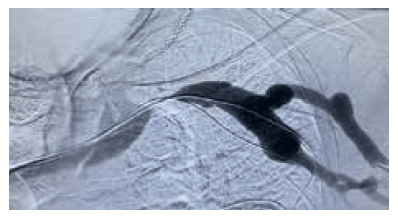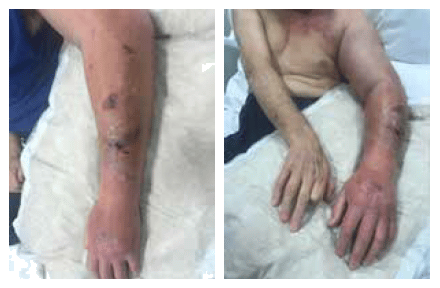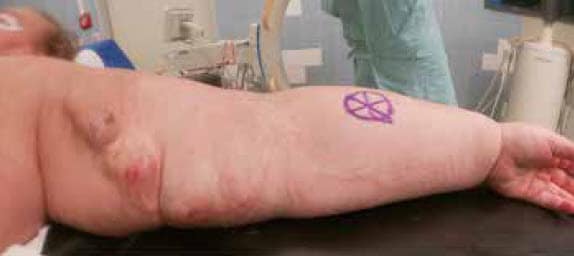Case Review 1
Treatment of Left Subclavian Vein Occlusion From a Large Sheath in the Upper Arm with a 16mm Diameter WRAPSODY™
DR. MATTHEW GIBSON
 Interventional Radiologist
Interventional Radiologist
Royal Berkshire Hospital, Reading, UK
CLINICAL HISTORY
An 85-year-old male patient on haemodialysis for 15 years with swollen left arm and reduced AV circuit competence. The image below shows a clinically significant subclavian stenosis.

RESULTS
The WRAPSODY demonstrated good apposition (no endoleak). The inflow and outflow showed no impingement on the lumen (device wide open).
Post operatively, the oedema in the patient’s left arm reduced dramatically. The dialysis flow rates improved to enable effective treatment.
Case Review 2
Treatment of a Recurrent Left Subclavian Vein Occlusion with WRAPSODY™
DR. DEAN HUANG
 Interventional Radiologist
Interventional Radiologist
King’s College Hospital, London, UK
CLINICAL HISTORY
A 56-year-old male patient on haemodialysis for 5 years with an history of eight previous venoplasty procedures to treat recurrent left subclavian vein stenosis, presented with a severe arm, face, and neck swelling, as shown in the image below.

RESULTS
The final venogram showed good angiographic result with no complication.
The sheaths were removed, and haemostasis was achieved with purse string suture at fistula puncture site and compression to groin puncture site. A CT scan was performed 7 days post-implantation, which showed a patent and well positioned WRAPSODY, minimal distal angulation to the course of the vein without significant stenosis.
Case Review 3
Treatment of a Cephalic Arch Stenosis with WRAPSODY™
DR. TOBIAS STEINKE
 Vascular Surgeon
Vascular Surgeon
Schön Klinik, Düsseldorf, Germany
CLINICAL HISTORY
A 42-year-old female patient with ESRD with an history of multiple reinterventions due to recurrent central vein stenosis presented with a dysfunctional left basilic AV fistula with an increasing symptomatic arm swelling due to a subtotal stenosis of the subclavian vein at the junction of the brachiocephalic vein.

RESULTS
The final venogram showed good angiographic result with no complication.
The sheath was removed, and hemostasis was achieved using a purse string suture.
Post operatively, the oedema in the patient’s left arm reduced dramatically. The dialysis flow rates improved to enable effective treatment.